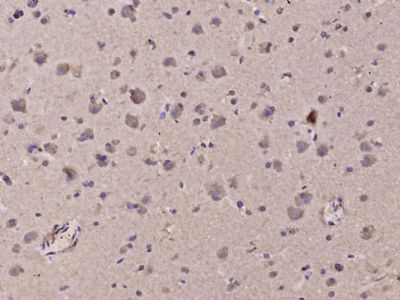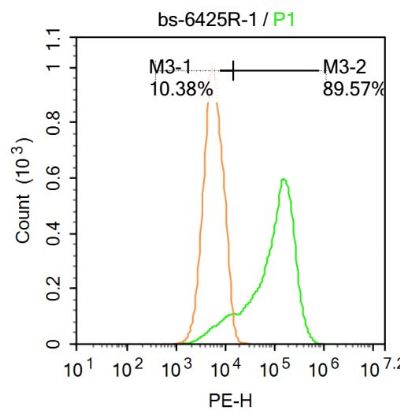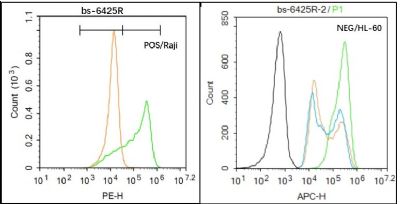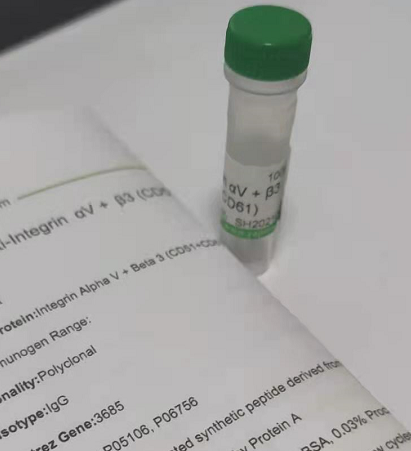| 產(chǎn)品編號 | YS-6425R |
| 英文名稱 | TRP12/TRPV4 |
| 中文名稱 | 瞬時受體電位蛋白12抗體 |
| 別 名 | osm-9-like TRP channel 4; OTRPC 4; OTRPC4; Transient receptor potential cation channel subfamily V member 4; Transient receptor potential protein 12; TRP 12; TRP12; TRPV 4; Vanilloid receptor-like channel 2; Vanilloid receptor-like protein 2; Vanilloid receptor-related osmotically-activated channel; VR 4; VR OAC; VR4; VRL 2; VRL2; VROAC. |
| 抗體來源 | Rabbit |
| 克隆類型 | Polyclonal |
| 交叉反應(yīng) | Human, (predicted: Mouse, Rat, Chicken, Dog, Pig, Cow, ) |
| 產(chǎn)品應(yīng)用 | ELISA=1:5000-10000 IHC-P=1:100-500 Flow-Cyt=1ug/test (石蠟切片需做抗原修復(fù)) not yet tested in other applications. optimal dilutions/concentrations should be determined by the end user. |
| 理論分子量 | 96kDa |
| 細(xì)胞定位 | 細(xì)胞漿 細(xì)胞膜 |
| 性 狀 | Liquid |
| 濃 度 | 1mg/ml |
| 免 疫 原 | KLH conjugated synthetic peptide derived from human TRPV4: 301-400/871 |
| 亞 型 | IgG |
| 純化方法 | affinity purified by Protein A |
| 緩 沖 液 | 0.01M TBS(pH7.4) with 1% BSA, 0.03% Proclin300 and 50% Glycerol. |
| 保存條件 | Shipped at 4℃. Store at -20 °C for one year. Avoid repeated freeze/thaw cycles. |
| 注意事項(xiàng) | This product as supplied is intended for research use only, not for use in human, therapeutic or diagnostic applications. |
| PubMed | PubMed |
| 產(chǎn)品介紹 | The detection of noxious stimuli (chemical, mechanical, or thermal) occurs predominantly at the peripheral terminals of primary afferent neurons. This information is ultimately transmitted to the central nervous system to evoke appropriate protective reflexes. TRPV4 is a non selective calcium permeant, swell activated, cation channel probably involved in osmotic and mechano sensitivity. Activation by exposure to hypotonicity within the physiological range, low pH, citrate and phorbol esters exhibits an outward rectification. Once activated the channel seems to be regulated in a calmodulin dependent manner, with a negative feedback mechanism. Function: Non-selective calcium permeant cation channel probably involved in osmotic sensitivity and mechanosensitivity. Activation by exposure to hypotonicity within the physiological range exhibits an outward rectification. Also activated by low pH, citrate and phorbol esters. Increase of intracellular Ca(2+) potentiates currents. Channel activity seems to be regulated by a calmodulin-dependent mechanism with a negative feedback mechanism. Promotes cell-cell junction formation in skin keratinocytes and plays an important role in the formation and/or maintenance of functional intercellular barriers. Acts as a regulator of intracellular Ca(2+) in synoviocytes. Plays an obligatory role as a molecular component in the nonselective cation channel activation induced by 4-alpha-phorbol 12,13-didecanoate and hypotonic stimulation in synoviocytes and also regulates production of IL-8. Subunit: Homotetramer (Probable). Self-associates in a isoform-specific manner. Isoforms 1/A and 5/D but not isoform 2/B, 4/C and 6/E can oligomerize. Interacts with calmodulin. Interacts with Map7 and Src family Tyr protein kinases LYN, SRC, FYN, HCK, LCK and YES. Interacts with CTNNB1. The TRPV4 and CTNNB1 complex can interact with CDH1. Part of a complex containing MLC1, AQP4, HEPACAM and ATP1B1. Subcellular Location: Cell membrane; Multi-pass membrane protein. Cell junction, adherens junction. Note=Assembly of the putative homotetramer occurs primarily in the endoplasmic reticulum. Isoform 1: Cell membrane. Isoform 5: Cell membrane. Tissue Specificity: Found in the synoviocytes from patients with (RA) and without (CTR) rheumatoid arthritis (at protein level). Post-translational modifications: Phosphorylation results in enhancement of its channel function. DISEASE: Defects in TRPV4 are the cause of brachyolmia type 3 (BRAC3) [MIM:113500]; also known as brachyrachia. The brachyolmias constitute a clinically and genetically heterogeneous group of skeletal dysplasias characterized by a short trunk, scoliosis and mild short stature. BRAC3 is an autosomal dominant form with severe kyphoscoliosis and flattened, irregular cervical vertebrae. Defects in TRPV4 are the cause of spondylometaphyseal dysplasia Kozlowski type (SMDK) [MIM:184252]. The spondylometaphyseal dysplasias (SMDs) are a group of short-stature disorders distinguished by abnormalities in the vertebrae and the metaphyses of the tubular bones. SMDK is an autosomal dominant disorder characterized by significant scoliosis and mild metaphyseal abnormalities in the pelvis. The vertebrae exhibit platyspondyly and overfaced pedicles. Similarity: Belongs to the transient receptor (TC 1.A.4) family. TrpV subfamily. TRPV4 sub-subfamily. Contains 3 ANK repeats. SWISS: Q9HBA0 Gene ID: 59341 |
| 產(chǎn)品圖片 |  Paraformaldehyde-fixed, paraffin embedded (Human brain glioma); Antigen retrieval by microwave in sodium citrate buffer (pH6.0) ; Block endogenous peroxidase by 3% hydrogen peroxide for 30 minutes; Blocking buffer (3% BSA) at RT for 30min; Antibody incubation with (TRP12) Polyclonal Antibody, Unconjugated (bs-6425R) at 1:400 overnight at 4°C, followed by conjugation to the secondary antibody (labeled with HRP)and DAB staining.  Blank control: Raji. Primary Antibody (green line): Rabbit Anti-TRP12 antibody (bs-6425R) Dilution: 1μg /10^6 cells; Isotype Control Antibody (orange line): Rabbit IgG . Secondary Antibody : Goat anti-rabbit IgG-PE Dilution: 1μg /test. Protocol The cells were fixed with 4% PFA (10min at room temperature)and then permeabilized with PBST for 20 min at room temperature. The cells were then incubated in 5%BSA to block non-specific protein-protein interactions for 30 min at at room temperature .Cells stained with Primary Antibody for 30 min at room temperature. The secondary antibody used for 40 min at room temperature. Acquisition of 20,000 events was performed.  Black line : Positive blank control (Raji); Negative blank control (HL60) Green line : Primary Antibody (Rabbit Anti-TRP12 antibody (bs-6425R) ) Orange line:Isotype Control Antibody (Rabbit IgG) . Blue line : Secondary Antibody (Goat anti-rabbit IgG-PE)/(Goat anti-rabbit IgG-AF647) Raji(Positive)and HL60(Negative control)cells (black) were fixed with 4% PFA for 10min at room temperature, permeabilized with PBST for 20 min at room temperature, and incubated in 5% BSA blocking buffer for 30 min at room temperature. Cells were then stained with TRP12 Antibody(bs-6425R)at 1:50 dilution in blocking buffer and incubated for 30 min at room temperature, washed twice with 2% BSA in PBS, followed by secondary antibody(blue) incubation for 40 min at room temperature. Acquisitions of 20,000 events were performed. Cells stained with primary antibody (green), and isotype control (orange). |
我要詢價
*聯(lián)系方式:
(可以是QQ、MSN、電子郵箱、電話等,您的聯(lián)系方式不會被公開)
*內(nèi)容:









